Development of a Screening Platform for Optimizing Chemical Nanosensor Materials
Abstract
1. Introduction
2. Materials and Methods
2.1. Platform Screening Chip and Gas Measurement Setup
2.2. Synthesis of Nanoparticles
2.3. Functionalization of the Sensor Films with Nanoparticle Solutions
2.4. Characterization of Nanoparticles on Sensor Surface
3. Results
3.1. TEM Characterization of Nanoparticles
3.2. Sensor Performance Measurement Procedure
3.3. Response of Bare and Au-, NiPt-, and Pd-NP Functionalized SnO2 Sensors towards CO and HCMix
4. Discussion
- Au-NPs: the sensor responses for CO and HCmix are increased, both showing a similar dependence on the NP concentration and reaching a maximum for a 1:1 Au-NP ink concentration.
- NiPt-NPs: the sensor responses for CO and HCmix are significantly increased, show a clear dependence on the NP concentration, and reach a maximum around the 1:1 NiPt-NP ink concentration for the CO, and between the 1:2 and 1:4 NiPt-NP ink concentration for the HCmix. The dip of the CO response for a 1:2 NiPt-NP concentration cannot be explained but has been reproducible in all investigated samples.
- Pd-NPs: the results are significantly different, the sensor responses both for CO and HCmix are decreased through the Pd-NP functionalization. Again, there is a dip for both responses for a 1:2 Pd-NP concentration, which cannot be explained, but has been reproducible in all investigated samples.
5. Conclusions and Outlook
Author Contributions
Funding
Institutional Review Board Statement
Informed Consent Statement
Data Availability Statement
Conflicts of Interest
References
- Korotcenkov, G. Gas Response Control through Structural and Chemical Modification of Metal Oxide Films: State of the Art and Approaches. Sens. Actuators B Chem. 2005, 107, 209–232. [Google Scholar] [CrossRef]
- Barsan, N.; Koziej, D.; Weimar, U. Metal Oxide-Based Gas Sensor Research: How To? Sens. Actuators B Chem. 2007, 121, 18–35. [Google Scholar] [CrossRef]
- Korotcenkov, G. Metal Oxides for Solid-State Gas Sensors: What Determines Our Choice? Mater. Sci. Eng. B 2007, 139, 1–23. [Google Scholar] [CrossRef]
- Capone, S.; Zuppa, M.; Presicce, D.S.; Francioso, L.; Casino, F.; Siciliano, P. Metal Oxide Gas Sensor Array for the Detection of Diesel Fuel in Engine Oil. Sens. Actuators B Chem. 2008, 131, 125–133. [Google Scholar] [CrossRef]
- Fleischer, M. Advances in Application Potential of Adsorptive-Type Solid State Gas Sensors: High-Temperature Semiconducting Oxides and Ambient Temperature GasFET Devices. Meas. Sci. Technol. 2008, 19, 42001. [Google Scholar] [CrossRef]
- Dey, A. Semiconductor Metal Oxide Gas Sensors: A Review. Mater. Sci. Eng. B 2018, 229, 206–217. [Google Scholar] [CrossRef]
- Comini, E. Metal Oxide Nano-Crystals for Gas Sensing. Anal. Chim. Acta 2006, 568, 28–40. [Google Scholar] [CrossRef]
- Brunet, E.; Maier, T.; Mutinati, G.C.; Steinhauer, S.; Köck, A.; Gspan, C.; Grogger, W. Comparison of the Gas Sensing Performance of SnO2 Thin Film and SnO2 Nanowire Sensors. Sens. Actuators B Chem. 2012, 165, 110–118. [Google Scholar] [CrossRef]
- Keskinen, H.; Tricoli, A.; Marjamäki, M.; Mäkelä, J.M.; Pratsinis, S.E. others Size-Selected Agglomerates of SnO2 Nanoparticles as Gas Sensors. J. Appl. Phys. 2009, 106, 084316. [Google Scholar] [CrossRef]
- Sun, Y.-F.; Liu, S.-B.; Meng, F.-L.; Liu, J.-Y.; Jin, Z.; Kong, L.-T.; Liu, J.-H. Metal Oxide Nanostructures and Their Gas Sensing Properties: A Review. Sensors 2012, 12, 2610–2631. [Google Scholar] [CrossRef]
- Kim, K.-W.; Cho, P.-S.; Kim, S.-J.; Lee, J.-H.; Kang, C.-Y.; Kim, J.-S.; Yoon, S.-J. The Selective Detection of C2H5OH Using SnO2--ZnO Thin Film Gas Sensors Prepared by Combinatorial Solution Deposition. Sens. Actuators B Chem. 2007, 123, 318–324. [Google Scholar] [CrossRef]
- Korotcenkov, G.; Cho, B.K. Engineering Approaches for the Improvement of Conductometric Gas Sensor Parameters: Part 1. Improvement of Sensor Sensitivity and Selectivity (Short Survey). Sens. Actuators B Chem. 2013, 188, 709–728. [Google Scholar] [CrossRef]
- Zhang, J.; Liu, X.; Neri, G.; Pinna, N. Nanostructured Materials for Room-Temperature Gas Sensors. Adv. Mater. 2016, 28, 795–831. [Google Scholar] [CrossRef]
- Korotcenkov, G.; Cho, B.K. Metal Oxide Composites in Conductometric Gas Sensors: Achievements and Challenges. Sens. Actuators B Chem. 2017, 244, 182–210. [Google Scholar] [CrossRef]
- Miller, D.R.; Akbar, S.A.; Morris, P.A. Nanoscale Metal Oxide-Based Heterojunctions for Gas Sensing: A Review. Sens. Actuators B Chem. 2014, 204, 250–272. [Google Scholar] [CrossRef]
- Xue, X.; Xing, L.; Chen, Y.; Shi, S.; Wang, Y.; Wang, T. Synthesis and H2S Sensing Properties of CuO-SnO2 Core/Shell Pn-Junction Nanorods. J. Phys. Chem. C 2008, 112, 12157–12160. [Google Scholar] [CrossRef]
- Park, S.; An, S.; Mun, Y.; Lee, C. UV-Enhanced NO2 Gas Sensing Properties of SnO2-Core/ZnO-Shell Nanowires at Room Temperature. ACS Appl. Mater. Interfaces 2013, 5, 4285–4292. [Google Scholar] [CrossRef]
- Lupan, O.; Braniste, T.; Deng, M.; Ghimpu, L.; Paulowicz, I.; Mishra, Y.K.; Kienle, L.; Adelung, R.; Tiginyanu, I. Rapid Switching and Ultra-Responsive Nanosensors Based on Individual Shell--Core Ga2O3/GaN: Ox@ SnO2 Nanobelt with Nanocrystalline Shell in Mixed Phases. Sens. Actuators B Chem. 2015, 221, 544–555. [Google Scholar] [CrossRef]
- Rabis, A.; Kramer, D.; Fabbri, E.; Worsdale, M.; Kotz, R.; Schmidt, T.J. Catalyzed SnO2 Thin Films: Theoretical and Experimental Insights into Fabrication and Electrocatalytic Properties. J. Phys. Chem. C 2014, 118, 11292–11302. [Google Scholar] [CrossRef]
- Bae, J.; Kim, J.; Jeong, H.; Lee, H. CO Oxidation on SnO2 Surfaces Enhanced by Metal Doping. Catal. Sci. Technol. 2018, 8, 782–789. [Google Scholar] [CrossRef]
- Guo, J.; Zhang, J.; Gong, H.; Ju, D.; Cao, B. Au Nanoparticle-Functionalized 3D SnO2 Microstructures for High Performance Gas Sensor. Sens. Actuators B Chem. 2016, 226, 266–272. [Google Scholar] [CrossRef]
- Tofighi, G.; Degler, D.; Junker, B.; Müller, S.; Lichtenberg, H.; Wang, W.; Weimar, U.; Barsan, N.; Grunwaldt, J.-D. Microfluidically Synthesized Au, Pd and AuPd Nanoparticles Supported on SnO2 for Gas Sensing Applications. Sens. Actuators B Chem. 2019, 292, 48–56. [Google Scholar] [CrossRef]
- Lin, Y.-H.; Hsueh, Y.-C.; Lee, P.-S.; Wang, C.-C.; Wu, J.M.; Perng, T.-P.; Shih, H.C. Fabrication of Tin Dioxide Nanowires with Ultrahigh Gas Sensitivity by Atomic Layer Deposition of Platinum. J. Mater. Chem. 2011, 21, 10552–10558. [Google Scholar] [CrossRef]
- Sun, G.-J.; Choi, S.-W.; Jung, S.-H.; Katoch, A.; Kim, S.S. V-Groove SnO2 Nanowire Sensors: Fabrication and Pt-Nanoparticle Decoration. Nanotechnology 2012, 24, 25504. [Google Scholar] [CrossRef]
- Steinhauer, S.; Lackner, E.; Sosada-Ludwikowska, F.; Singh, V.; Krainer, J.; Wimmer-Teubenbacher, R.; Grammatikopoulos, P.; Köck, A.; Sowwan, M. Atomic-Scale Structure and Chemical Sensing Application of Ultrasmall Size-Selected Pt Nanoparticles Supported on SnO2. Mater. Adv. 2020, 1, 3200–3207. [Google Scholar] [CrossRef]
- Sosada-Ludwikowska, F.; Reiner, L.; Egger, L.; Lackner, E.; Krainer, J.; Wimmer-Teubenbacher, R.; Singh, V.; Steinhauer, S.; Grammatikopoulos, P.; Köck, A. Adjusting Surface Coverage of Pt Nanocatalyst Decoration for Selectivity Control in CMOS-Integrated SnO2 Thin Film Gas Sensors. Nanoscale Adv. 2024, 6, 1127–1134. [Google Scholar] [CrossRef]
- Wang, R.; Suhdi, S.C. Gold-Nanoparticle-Decorated Tin Oxide of a Gas Sensor Material for Detecting Low Concentrations of Hydrogen Sulfide. Sens. Mater. 2023, 35, 1121. [Google Scholar]
- Peng, S.; Lee, Y.; Wang, C.; Yin, H.; Dai, S.; Sun, S. A Facile Synthesis of Monodisperse Au Nanoparticles and Their Catalysis of CO Oxidation. Nano Res. 2008, 1, 229–234. [Google Scholar] [CrossRef]
- Wu, B.-H.; Yang, H.-Y.; Huang, H.-Q.; Chen, G.-X.; Zheng, N.-F. Solvent Effect on the Synthesis of Monodisperse Amine-Capped Au Nanoparticles. Chin. Chem. Lett. 2013, 24, 457–462. [Google Scholar] [CrossRef]
- Wang, C.; Daimon, H.; Lee, Y.; Kim, J.; Sun, S. Synthesis of Monodisperse Pt Nanocubes and Their Enhanced Catalysis for Oxygen Reduction. J. Am. Chem. Soc. 2007, 129, 6974–6975. [Google Scholar] [CrossRef]
- Mazumder, V.; Sun, S. Oleylamine-Mediated Synthesis of Pd Nanoparticles for Catalytic Formic Acid Oxidation. J. Am. Chem. Soc. 2009, 131, 4588–4589. [Google Scholar] [CrossRef] [PubMed]
- Gangwar, A.K.; Srivastava, S.; Godiwal, R.; Jaiswal, J.; Vashishtha, P.; Pal, S.; Pal, P.; Gupta, G.; Singh, P. Room Temperature Sputtered Nanocrystalline SnO2 Thin Films Sensitized with Pd Nanoparticles for High Performance CO Gas Sensing Application. Opt. Mater. 2022, 128, 112362. [Google Scholar] [CrossRef]
- Tischner, A.; Maier, T.; Stepper, C.; Köck, A. Ultrathin SnO2 Gas Sensors Fabricated by Spray Pyrolysis for the Detection of Humidity and Carbon Monoxide. Sens. Actuators B Chem. 2008, 134, 796–802. [Google Scholar] [CrossRef]
- Köck, A.; Deluca, M.; Sosada-Ludwikowska, F.; Maier, G.; Teubenbacher, R.W.; Sagmeister, M.; Rohracher, K.; Wachmann, E.; Niehaus, J.S.; Becker, S.; et al. Heterogeneous Integration of Metal Oxides—Towards a CMOS Based Multi Gas Sensor Device. Multidiscip. Digit. Publ. Inst. Proc. 2019, 14, 5. [Google Scholar] [CrossRef]
- Maier, G.A.; Krobath, M.; Kremsner, C.; Köck, A. A Novel Device for Functional Evaluation of Gas Sensing Layers. Proceedings 2018, 2, 1012. [Google Scholar] [CrossRef]
- Yang, Y.; Maeng, B.; Jung, D.G.; Lee, J.; Kim, Y.; Kwon, J.; An, H.K.; Jung, D. Annealing Effects on SnO2 Thin Film for H2 Gas Sensing. Nanomaterials 2022, 12, 3227. [Google Scholar] [CrossRef]
- Zhang, M.; Jiang, G. Gas Sensing Properties of Co3O4-Loaded SnO2 to Ethanol and Acetone. Chin. J. Chem. Phys. 2007, 20, 315. [Google Scholar] [CrossRef]
- Preiß, E.M.; Rogge, T.; Krauß, A.; Seidel, H. Gas Sensing by SnO2 Thin Films Prepared by Large-Area Pulsed Laser Deposition. Procedia Eng. 2015, 120, 88–91. [Google Scholar] [CrossRef][Green Version]
- Si, R.; Li, Y.; Tian, J.; Tan, C.; Chen, S.; Lei, M.; Xie, F.; Guo, X.; Zhang, S. Cross-Interference of VOCs in SnO2-Based NO Sensors. Nanomaterials 2023, 13, 908. [Google Scholar] [CrossRef]
- Permanent Senate Commission for the Investigation of Health Hazards of Chemical Compounds in the Work Area. List of MAK and BAT Values 2023. Occup. Environ. Med. 2003, 542. [Google Scholar]
- Korotcenkov, G.; Brinzari, V.; Gulina, L.B.; Cho, B.K. The Influence of Gold Nanoparticles on the Conductivity Response of SnO2-Based Thin Film Gas Sensors. Appl. Surf. Sci. 2015, 353, 793–803. [Google Scholar] [CrossRef]
- Zhu, Z.; Xing, X.; Feng, D.; Li, Z.; Tian, Y.; Yang, D. Highly Sensitive and Fast-Response Hydrogen Sensing of WO3 Nanoparticles via Palladium Reined Spillover Effect. Nanoscale 2021, 13, 12669–12675. [Google Scholar] [CrossRef] [PubMed]
- Sui, N.; Wei, X.; Cao, S.; Zhang, P.; Zhou, T.; Zhang, T. Nanoscale Bimetallic AuPt-Functionalized Metal Oxide Chemiresistors: Ppb-Level and Selective Detection for Ozone and Acetone. ACS Sens. 2022, 7, 2178–2187. [Google Scholar] [CrossRef]
- Malkov, I.V.; Krivetskii, V.V.; Potemkin, D.I.; Zadesenets, A.V.; Batuk, M.M.; Hadermann, J.; Marikutsa, A.V.; Rumyantseva, M.N.; Gas’kov, A.M. Effect of Bimetallic Pd/Pt Clusters on the Sensing Properties of Nanocrystalline SnO2 in the Detection of CO. Russ. J. Inorg. Chem. 2018, 63, 1007–1011. [Google Scholar] [CrossRef]


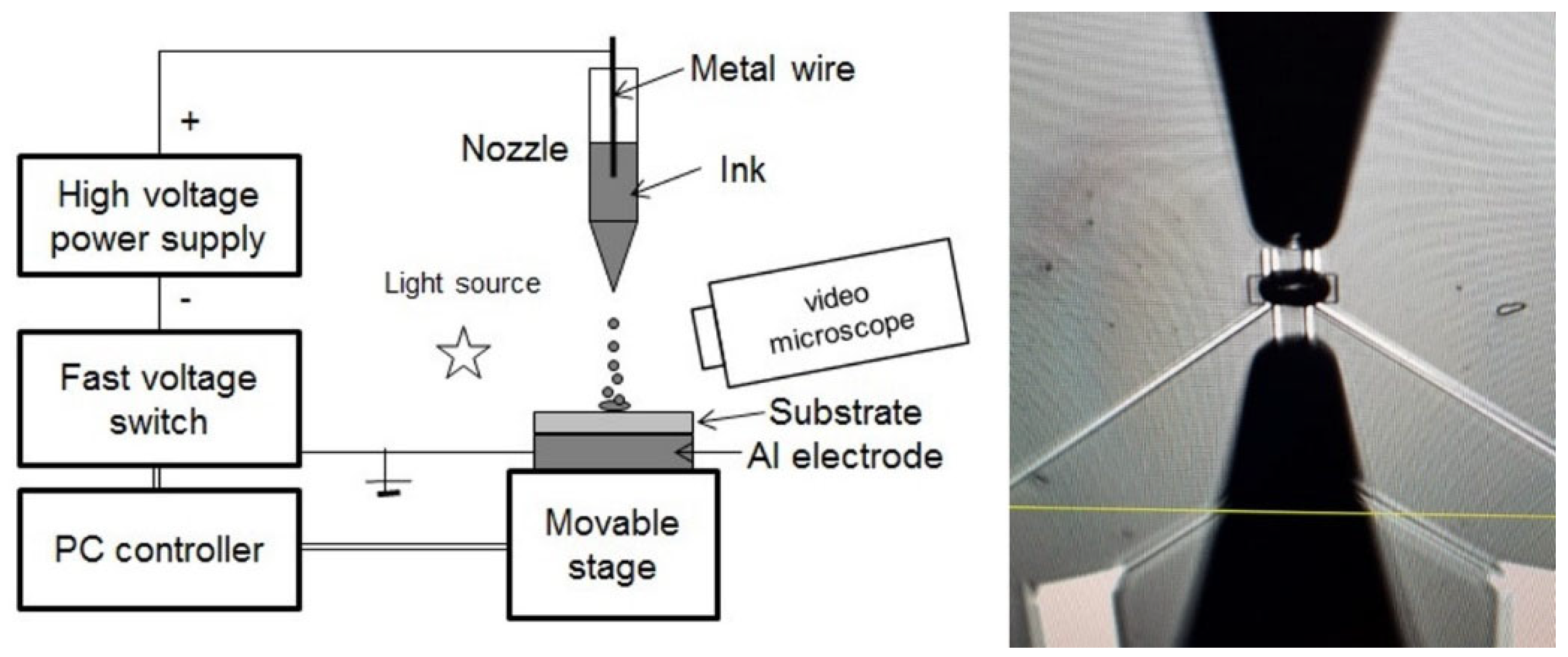

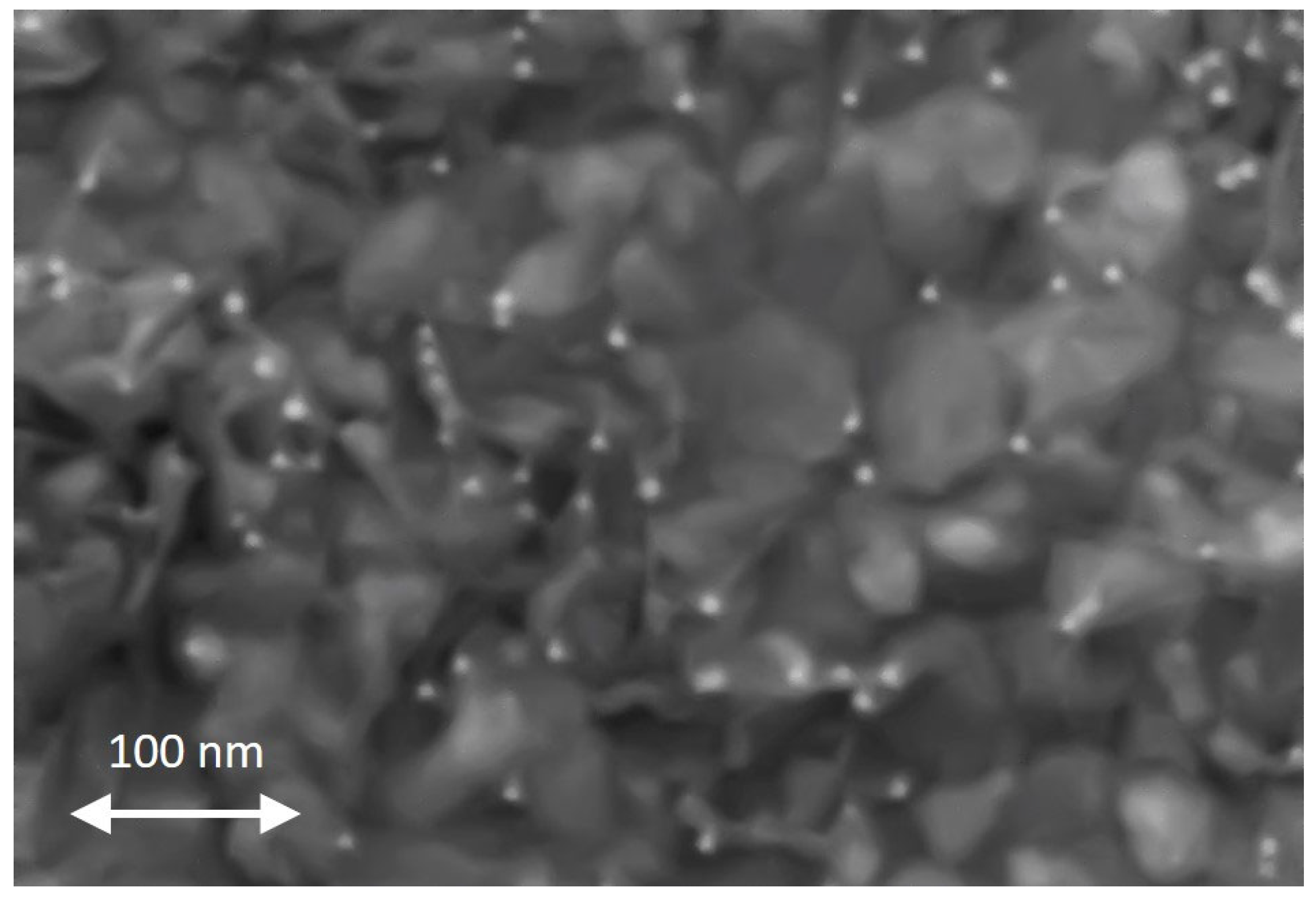
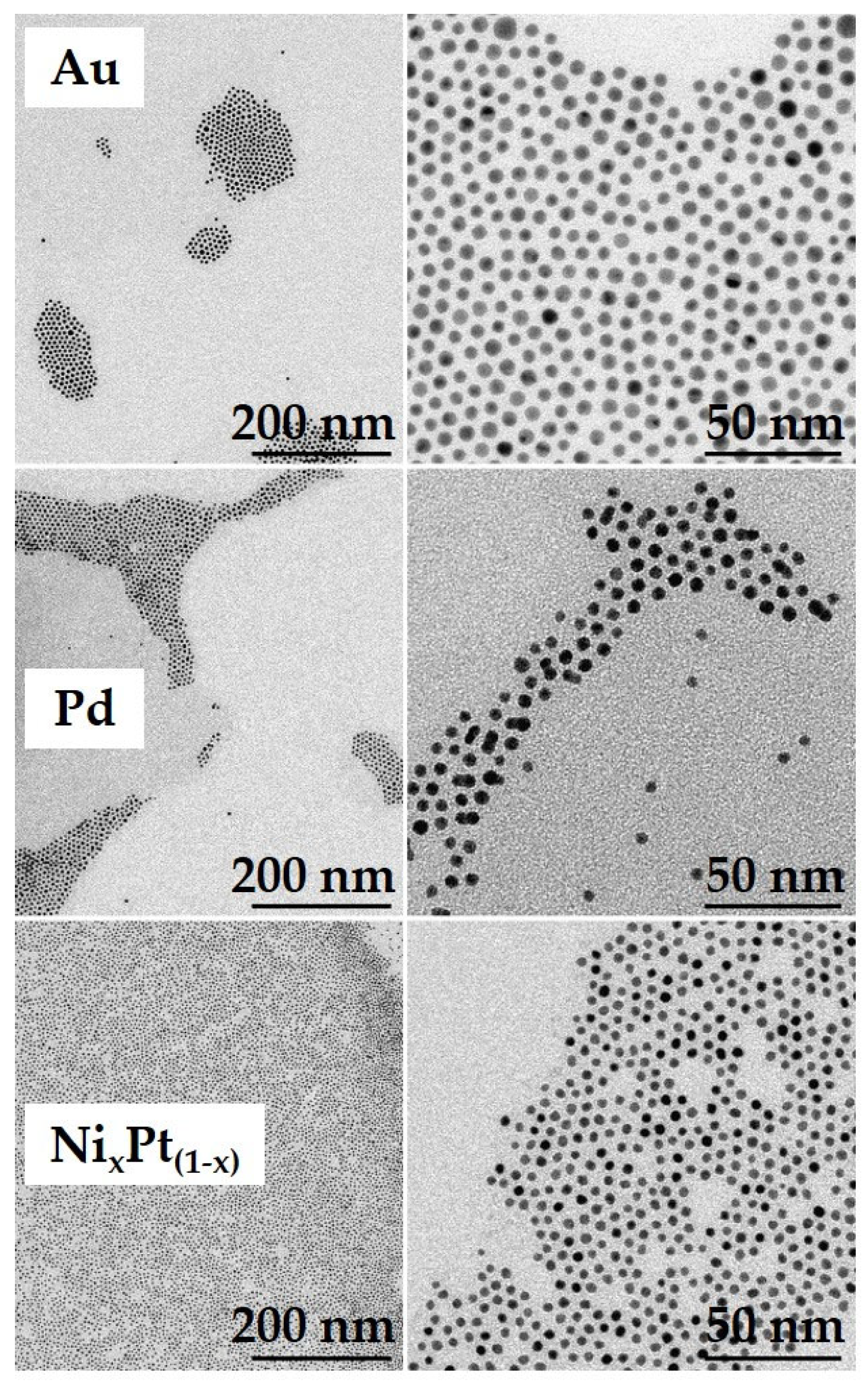

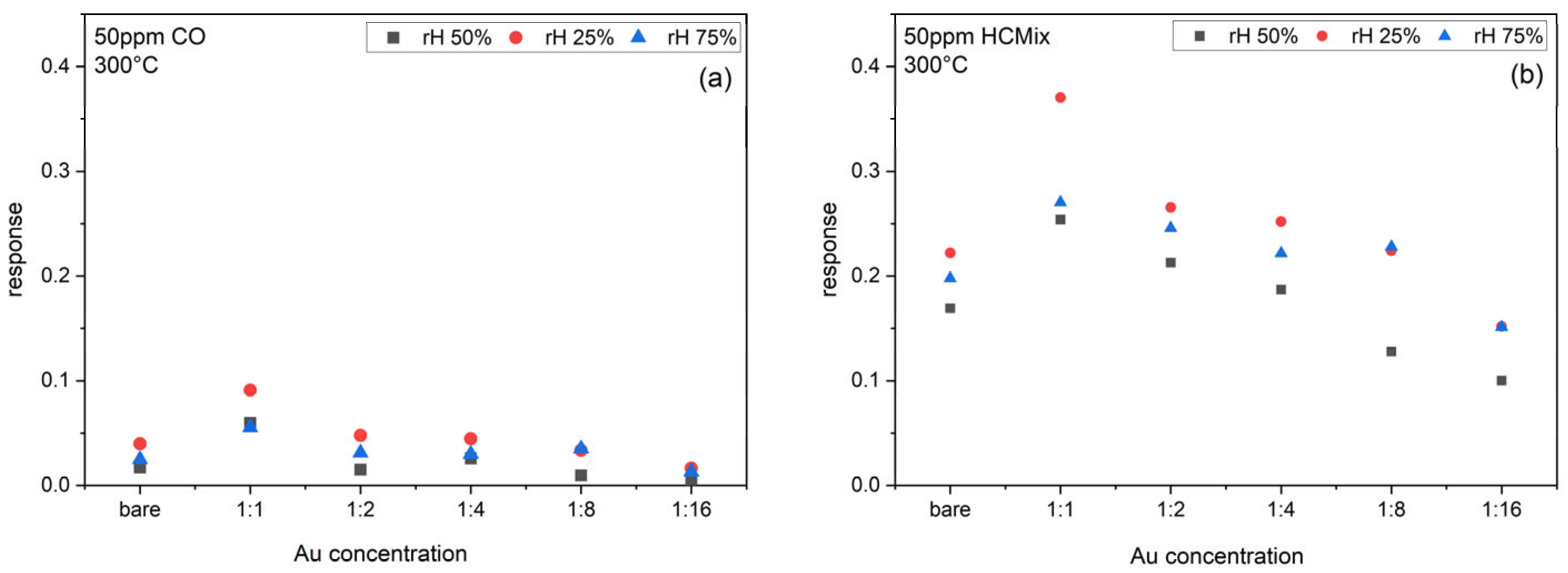

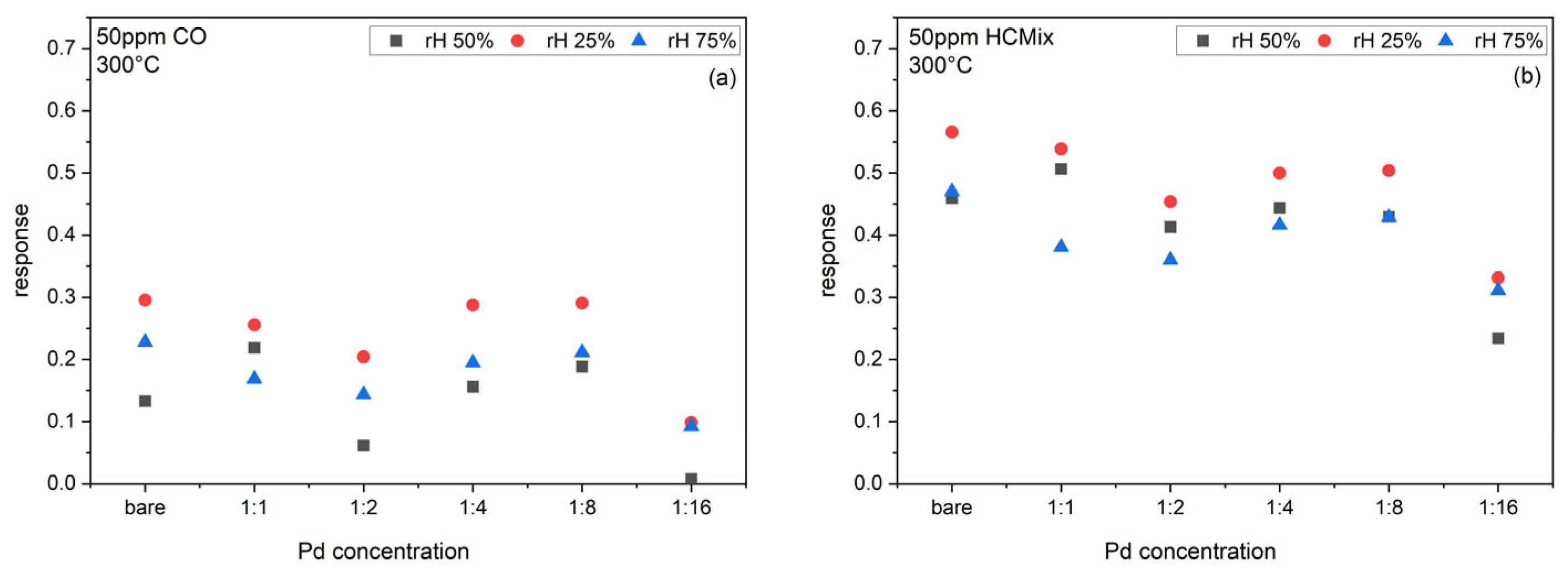
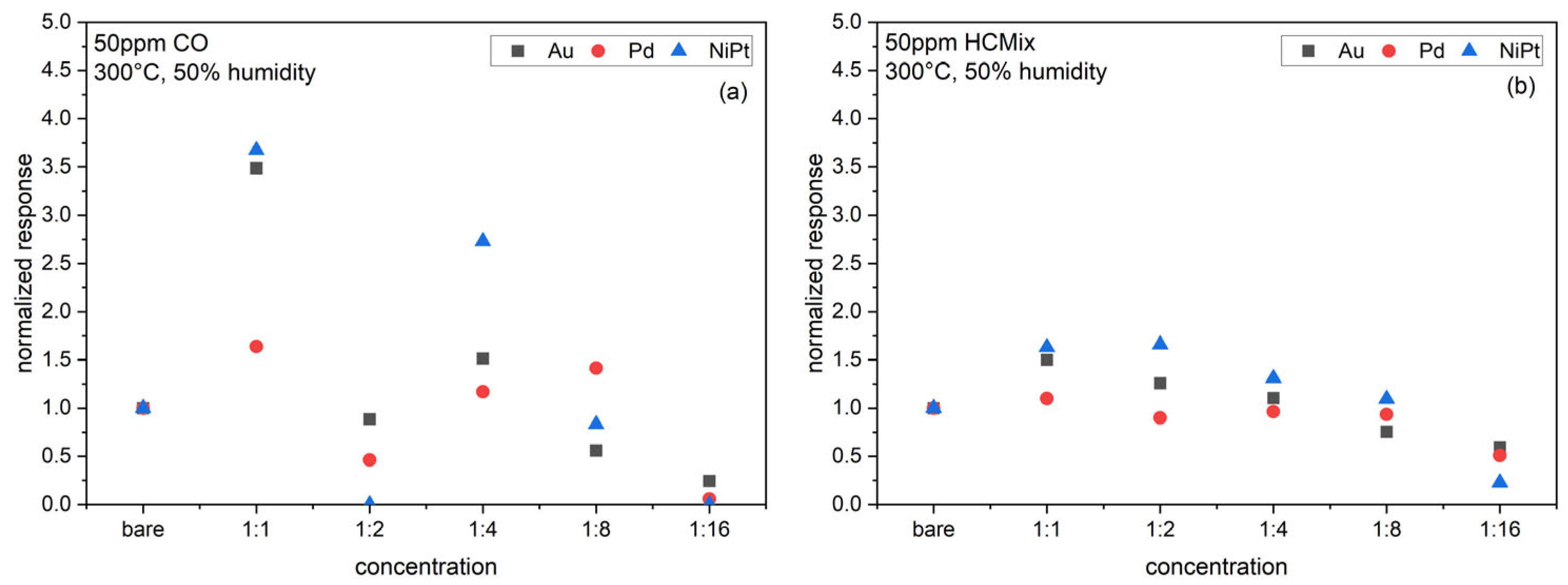
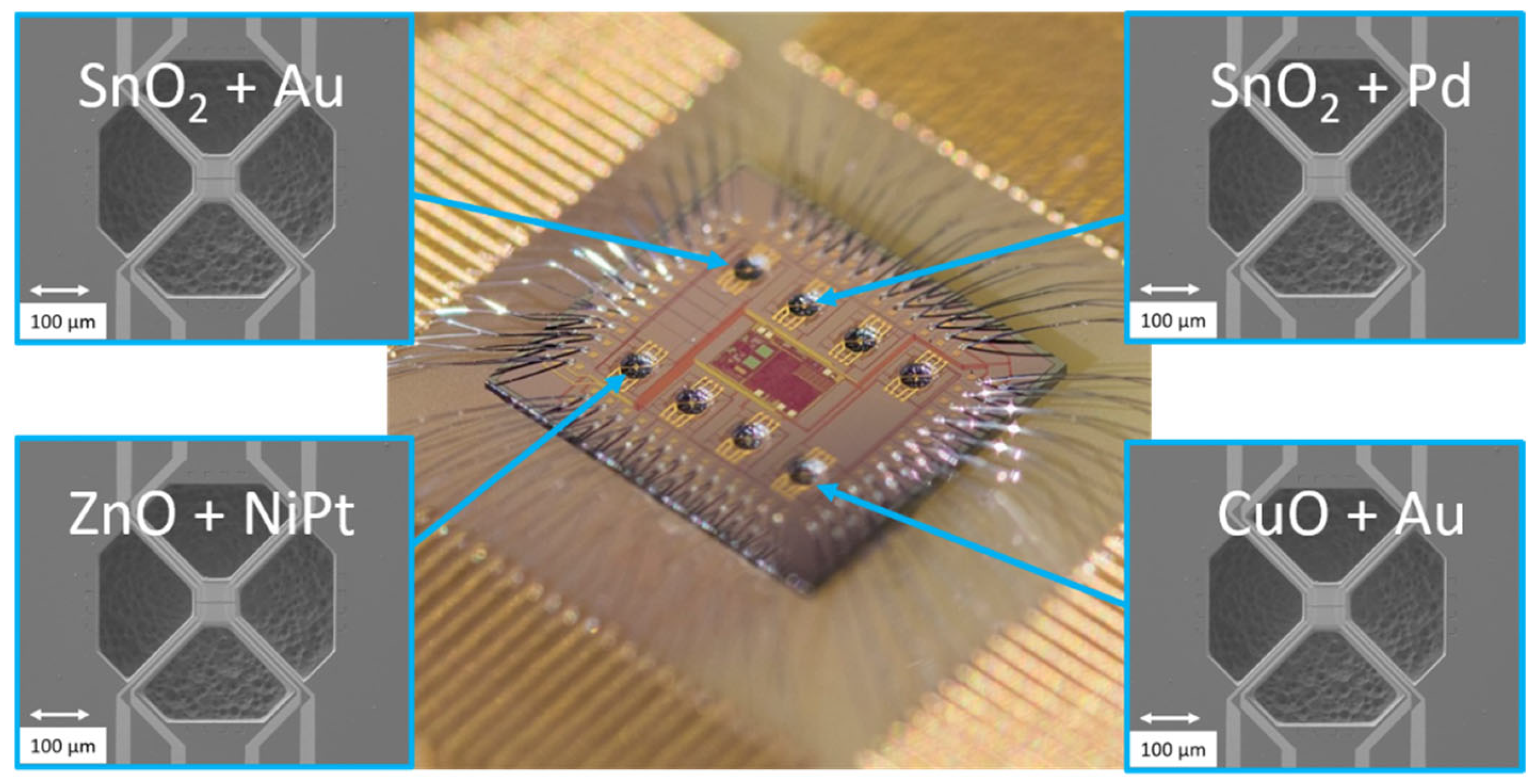
| Ink Lot. | V (NP Solution) | V (Octane) | V(1-Octanol) | V(Ink) | Au | NiPt | Pd |
|---|---|---|---|---|---|---|---|
| [mL] | NP Ink Concentration [M] | ||||||
| 1 | 1 | 0 | 4 | 5 | 1.22 × 10−6 | 1.70 × 10−6 | 3.19 × 10−6 |
| 1/2 | 0.5 | 0.5 | 4 | 5 | 6.08 × 10−7 | 8.52 × 10−7 | 1.60 × 10−6 |
| 1/4 | 0.25 | 0.75 | 4 | 5 | 3.04 × 10−7 | 4.26 × 10−7 | 7.98 × 10−7 |
| 1/8 | 0.125 | 0.875 | 4 | 5 | 1.52 × 10−7 | 2.13 × 10−7 | 3.99 × 10−7 |
| 1/16 | 0.0625 | 0.9375 | 4 | 5 | 7.59 × 10−8 | 1.07 × 10−7 | 2.00 × 10−7 |
Disclaimer/Publisher’s Note: The statements, opinions and data contained in all publications are solely those of the individual author(s) and contributor(s) and not of MDPI and/or the editor(s). MDPI and/or the editor(s) disclaim responsibility for any injury to people or property resulting from any ideas, methods, instructions or products referred to in the content. |
© 2024 by the authors. Licensee MDPI, Basel, Switzerland. This article is an open access article distributed under the terms and conditions of the Creative Commons Attribution (CC BY) license (https://creativecommons.org/licenses/by/4.0/).
Share and Cite
Egger, L.; Reiner, L.; Sosada-Ludwikowska, F.; Köck, A.; Schlicke, H.; Becker, S.; Tokmak, Ö.; Niehaus, J.S.; Blümel, A.; Popovic, K.; et al. Development of a Screening Platform for Optimizing Chemical Nanosensor Materials. Sensors 2024, 24, 5565. https://doi.org/10.3390/s24175565
Egger L, Reiner L, Sosada-Ludwikowska F, Köck A, Schlicke H, Becker S, Tokmak Ö, Niehaus JS, Blümel A, Popovic K, et al. Development of a Screening Platform for Optimizing Chemical Nanosensor Materials. Sensors. 2024; 24(17):5565. https://doi.org/10.3390/s24175565
Chicago/Turabian StyleEgger, Larissa, Lisbeth Reiner, Florentyna Sosada-Ludwikowska, Anton Köck, Hendrik Schlicke, Sören Becker, Öznur Tokmak, Jan Steffen Niehaus, Alexander Blümel, Karl Popovic, and et al. 2024. "Development of a Screening Platform for Optimizing Chemical Nanosensor Materials" Sensors 24, no. 17: 5565. https://doi.org/10.3390/s24175565
APA StyleEgger, L., Reiner, L., Sosada-Ludwikowska, F., Köck, A., Schlicke, H., Becker, S., Tokmak, Ö., Niehaus, J. S., Blümel, A., Popovic, K., & Tscherner, M. (2024). Development of a Screening Platform for Optimizing Chemical Nanosensor Materials. Sensors, 24(17), 5565. https://doi.org/10.3390/s24175565






